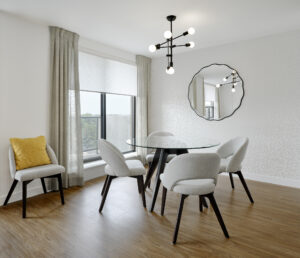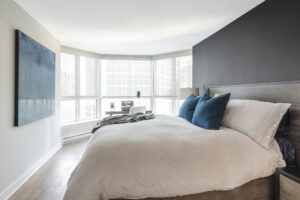Keeping It Simple With Minimalist Interior Design
Minimalist design is one of the most beloved interior decorating styles that’s been inspiring artists and designers for decades, and with good reason. It’s practical, it looks good and it’s not terribly expensive, making it ideal for many people who want their home to radiate a sense of calm and order without sacrificing practicality.
Although Minimalism is closely associated with Modernism, it’s ironically timeless in its elegance and grace. Let’s take a look at this iconic style’s essential elements and how you can incorporate them into your abode.
The Bare Bones of Minimalism
To understand Minimalism’s key characteristics, it may be helpful to know a little about its history in the West. The Minimalist interior design style and Minimalist architecture as we know them today emerged during the 1950s and became increasingly popular over the course of the following decade. They were largely an artistic and architectural response to the busy, colorful designs seen in Maximalist design back then.
As its name suggests, Minimalism is all about simplicity and functionality. It’s characterized by clean lines, simple forms, a monochromatic palette and negative space. That said, contrary to popular belief, the Minimalist aesthetic doesn’t demand that you design a cold and clinical environment that vaguely resembles a hospital operating theater.
Rather, the Minimalist approach aims to create a serene space free of chaos and clutter. You can expect to see furniture and decor that very obviously meets a specific need while still being aesthetically pleasing. There’s no embellishment for the sake of it, everything is driven by rhyme and reason. Forget any elaborate fixtures and fittings here!

This design style seeks to highlight a room’s architectural details cleanly and subtly. Minimalism also focuses on creating airy, open spaces that make the most of natural light. That’s why many Minimalist homes have open-plan layouts, avoiding small or cramped impressions.
You’ll also find large windows — sometimes spanning entire walls — and glass doors with simple steel or metal frames. Cupboards extend from the floor to the ceiling, making the most of an area’s vertical space. Storage room and efficiency are the name(s) of the game. After all, Minimalism prioritizes function over form, although aesthetics are still incredibly important, and quality materials are highly prized. So, good craftsmanship takes precedence over appearance.
Core Colors, Textures and Prints
As you might expect, a Minimalist color palette is rather muted. Neutral colors are a Minimalist’s best friends: Grays, browns, black and white make up most of a room’s color scheme. Many designers recommend that you choose three to four base colors, and maybe one or two accent colors to create the contrast for which Minimalism is so well-known.

Most of your variety is going to come from different shades of those foundational colors, rather than a wide range of wild ones. Importantly, make sure your selection consists of cool, warm, light and dark colors to create depth in a space. Your lighting can also create a balance of cool and warm colors. Select a range of fluorescent white lighting fixtures that can go alongside warmer, yellow ones.
Of course, the paint you use on your walls will supply the room with most of its pigments, but the materials you use are also a great source of color. Natural wood and stone are popular materials to work with in a Minimalist space because they can offer warmth and richness or coolness, depending on their undertones. For example, beige sandstone or cedar wood can work wonders alongside black marble, dark gray granite or deep mahogany. Steel and chrome are also highly favored because they cool down warm hues.
Now, you may be wondering, “Can I use patterns?” and the answer is yes, but sparingly and carefully. Horizontal or vertical stripes are a safe bet. Alternatively, stick with geometric designs that aren’t ornate — think basic shapes like triangles, squares and circles. Err on the side of caution when it comes to florals, paisley, filigrees or other such prints.
Making the Most of Less Furniture
As we mentioned before, every piece needs a purpose. When furnishing a Minimalist room, ask yourself what the room needs to do. This will inform what furniture you select. It’s also worth questioning how much of each type of furniture you need. Remember, Minimalism treats sparsity as a virtue. Fewer pieces help create an uncluttered space.
 This kitchen area has only what it needs: space to prepare food, wine and recipe books.
This kitchen area has only what it needs: space to prepare food, wine and recipe books.Let’s explore this more by using some specific rooms as examples. Take a living room, for instance. It serves as an entertainment area and a space to relax. So, you’ll need a couch on which to sit. How many couches? This will depend on how many guests or residents you expect to have in your home at any given time.
Similarly, a dining room needs a table and chairs to accommodate people having a meal. How many pieces do you need? That depends on how many people you plan to feed at once. Resist the temptation to add more than necessary!
Remember that contrast is your friend, so if you’ve opted for light floors and walls, go for darker furniture. A black couch pairs beautifully with cream walls and a light-wood or concrete floor; a white dining table can look stunning when placed on dark slate. That said, opt for modern furniture in similar shades so it stays in balance with the room as a whole.
Every piece of furniture should have clean, smooth lines, and your upholstery should be soft enough to produce an inviting atmosphere and create visual interest. But, be careful to keep your texture selection consistent across your pieces. While selecting your furniture, look for materials that are easy to clean. Silk isn’t your friend, but leather is.
Decorating a Minimalist Space That Sparks Joy
Needless to say, the golden rule with Minimalist decor is “less is more,” so be frugal here. Light fixtures, dangling pendants and lamps should be simple. Avert your gaze from any elaborate chandeliers! A copper or bronze standing lamp will do very nicely in a living room, and a bedside lamp with contrasting base and lampshade will be a wonderful addition to a bedroom. Bare bulbs are a Minimalist staple, so play around with them.
You may go for wall art, but remember that a Minimalist home isn’t a gallery. Limit yourself to one piece per room, and choose monochromatic photo prints or paintings with simple lines and silhouettes. Leave the Andy Warhol and Monet prints for another time. Speaking of color, you’re at liberty to incorporate a potted plant or two for a subtle pop of color, but stick to understated broad-leaf plants that don’t flower.
When it comes to drapery, lightly colored curtains in cream or white linen are the best choice for allowing as much light as possible into your Minimalist room. Steer clear of velvet and other heavy materials! Light wood shutters are also a good selection if you don’t want to worry about keeping fabric clean. Similarly, select delicate, earthy tones for your linen, but feel free to use the tiniest bit of color in your rugs or pillows to lightly accent a room.

Lastly, go for gold with modest metallic embellishments and decor. Crystal and glass are good choices for vases, bowls and other decorative items, but use them sparingly. Add a bookcase if you have some dearly beloved books you’d like to display, although you should refrain from adding bookshelves just for no reason in particular. In general, shy away from kitsch knick-knacks that serve no purpose, but the odd small ceramic statuette or basic wrought-iron candle holder here or there is fine.
Although Minimalism is inherently the opposite of complex, it can be deceptively simple. If you’d like to create a Minimalist room or home but think you might be at risk of doing too much, we’d be delighted to help! Simply contact us, and your personal decorator will set aside some time to chat about your goals. Then, they’ll pop in to get a feel of the space you want to decorate and create a plan. Once you’re happy with it, our team will get started on making your vision come to life.

